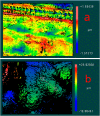A Novel Bio-carrier Fabricated Using 3D Printing Technique for Wastewater Treatment
- PMID: 26202477
- PMCID: PMC4648452
- DOI: 10.1038/srep12400
A Novel Bio-carrier Fabricated Using 3D Printing Technique for Wastewater Treatment
Abstract
The structure of bio-carriers is one of the key operational characteristics of a biofilm reactor. The goal of this study is to develop a series of novel fullerene-type bio-carriers using the three-dimensional printing (3DP) technique. 3DP can fabricate bio-carriers with more specialized structures compared with traditional fabrication processes. In this research, three types of fullerene-type bio-carriers were fabricated using the 3DP technique and then compared with bio-carrier K3 (from AnoxKaldnes) in the areas of physicochemical properties and biofilm growth. Images acquired by 3D profiling and SEM indicated that the surface roughness of the 3DP bio-carrier was greater than that of K3. Furthermore, contact angle data indicated that the 3DP bio-carriers were more hydrophilic than K3. The biofilm on the 3DP bio-carriers exhibited higher microbial activity and stronger adhesion ability. These findings were attributed to excellent mass transfer of the substrate (and oxygen) between the vapour-liquid-solid tri-phase system and to the surface characteristics. It is concluded that the novel 3DP fullerene-type bio-carriers are ideal carriers for biofilm adherence and growth.
Figures








Similar articles
-
Small-scale domestic wastewater treatment using an alternating pumped sequencing batch biofilm reactor system.Bioprocess Biosyst Eng. 2006 Apr;28(5):323-30. doi: 10.1007/s00449-005-0038-8. Epub 2006 Jan 12. Bioprocess Biosyst Eng. 2006. PMID: 16408190
-
Why use a thermophilic aerobic membrane reactor for the treatment of industrial wastewater/liquid waste?Environ Technol. 2015 Jul-Aug;36(13-16):2115-24. doi: 10.1080/09593330.2015.1021860. Epub 2015 Mar 23. Environ Technol. 2015. PMID: 25704477
-
Biodegradation of benzotriazoles and hydroxy-benzothiazole in wastewater by activated sludge and moving bed biofilm reactor systems.Bioresour Technol. 2015 Sep;192:627-35. doi: 10.1016/j.biortech.2015.06.035. Epub 2015 Jun 12. Bioresour Technol. 2015. PMID: 26093257
-
The membrane biofilm reactor (MBfR) for water and wastewater treatment: principles, applications, and recent developments.Bioresour Technol. 2012 Oct;122:83-94. doi: 10.1016/j.biortech.2012.02.110. Epub 2012 Mar 3. Bioresour Technol. 2012. PMID: 22541953 Review.
-
[Modern approaches to wastewater treatment].Lik Sprava. 2013 Apr-May;(3):102-5. Lik Sprava. 2013. PMID: 25016758 Review. Ukrainian.
Cited by
-
Improvement of MBBR-MBR Performance by the Addition of Commercial and 3D-Printed Biocarriers.Membranes (Basel). 2023 Jul 25;13(8):690. doi: 10.3390/membranes13080690. Membranes (Basel). 2023. PMID: 37623751 Free PMC article.
-
Analysis of very-high surface area 3D-printed media in a moving bed biofilm reactor for wastewater treatment.PLoS One. 2020 Aug 27;15(8):e0238386. doi: 10.1371/journal.pone.0238386. eCollection 2020. PLoS One. 2020. PMID: 32853235 Free PMC article.
-
3D-printed Bioreactors for In Vitro Modeling and Analysis.Int J Bioprint. 2020 Aug 18;6(4):267. doi: 10.18063/ijb.v6i4.267. eCollection 2020. Int J Bioprint. 2020. PMID: 33088992 Free PMC article. Review.
-
Innovative Coating-Etching Method of Biocarrier Fabrication for Treating Wastewater with a Low C/N Ratio.Polymers (Basel). 2022 Jul 25;14(15):3010. doi: 10.3390/polym14153010. Polymers (Basel). 2022. PMID: 35893972 Free PMC article.
-
3D-Printed Materials for Wastewater Treatment.JACS Au. 2023 Oct 26;3(11):2930-2947. doi: 10.1021/jacsau.3c00409. eCollection 2023 Nov 27. JACS Au. 2023. PMID: 38034974 Free PMC article. Review.
References
-
- Sachs E., Cima M., Williams P., Brancazio D. & Cornie J. Three Dimensional Printing: Rapid Tooling and Prototypes Directly from a CAD Model. J. Manuf. Sci. Eng. 114, 481–48810.1115/1.2900701 (1992) - DOI
-
- Lam C. X. F., Mo X. M., Teoh S. H. & Hutmacher D. W. Scaffold development using 3D printing with a starch-based polymer. Mater. Sci. Eng. C 20, 49–5610.1016/S0928-4931(02)00012-7 (2002). - DOI
-
- Scans E. M., Haggerty J. S. & Cima M. J. Three-dimensional printing technique. [P].US5204055 1993
Publication types
MeSH terms
Substances
LinkOut - more resources
Full Text Sources
Other Literature Sources

